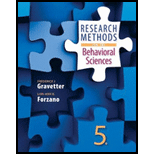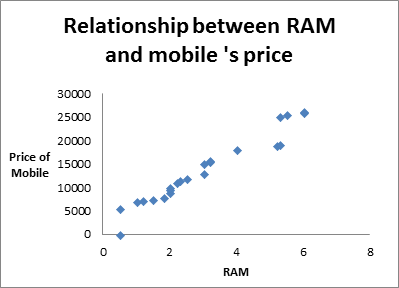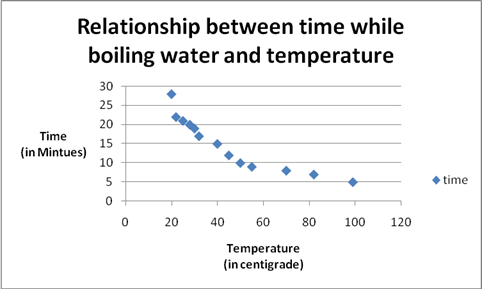
Concept explainers
In addition to the key words, you should also be able to define each of the following terms:
| Positive relationship | ratio scale |
| Negative relationship | self-report measure |
| Accuracy | physiological measure |
| Scale of measurement | behavioral measure |
| Nominal scale | |
| Ordinal scale | artifact |
| Interval scale | subject roles or subject role behaviors |
The definition of the following terms.
Explanation of Solution
Positive Relationship:
In statistics, a positive relationship or positive correlation is defined as the relationship between two variables in which, increment (decrement) in one variable results in increment(decrement) of another variable (not necessarily in same ratio). In other words, positive relationship is the relationship between the two variables in which both variable moves in same direction.
For example, increment in RAM results in increment in price of mobile. The positive relationship can also be seen graphically through scatter plot.

Negative Relationship:
In statistical terms, a negative relationship or negative correlation is defined as the relationship between two variables in which both the variables move in opposite direction, that is, increment(decrement) in the value of one variable results in decrement (increment) of other.
For example, on increasing the temperature of microwave, the time taken by water to boil is decreased.

Accuracy:
Statistics is not about deterministic value, it's about estimated value which is close to accurate value. While doing an experiment, one can never get exact value. So accuracy tells the closeness between true value and estimated value.
For example, a sample is drawn from a population having mean 30 and the sample mean is 29 then one can say that sample mean is accurate to within 1 unit.
Scale of Measurement:
The term 'measurement' is used in our daily lives very broadly but in statistics, the term 'scale of measurement' is used which is more appropriate and is used to categorize the variables. The scale of measurement gives some ways to categorize the variables. The scale of measurement is divided into four scales- nominal, ordinal, interval and ratio scale. Each scale has its own properties on the basis of which the variables can be categorized. This categorization is very useful while performing statistical analysis and without this categorization, it is not possible to perform analysis. The scale of measurement works as base of statistical analysis.
Nominal Scale:
The scale which consists of variables having categories and do not have any order is known as nominal scales and the variables are known as nominal or categorical variables. These variables are simply used as identifiers such as blood group (AB, A, B, O), gender (male and female), residential area (urban and rural) etc.
In this, categories of any variables can be assigned the codes in the form of the numbers and those numbers work as the labels. For a variable gender, male can be assigned as 0 and females as 1.
Ordinal Scale:
The ordinal scale contains the variables having categories and should be placed in order and the variables are known as ordinal variables. For example, ranks achieved in drawing competition, that is, first, second and third positions.
This scale is not used to represent the quantity.
Interval Scale:
The term 'interval' means 'gap in between' which shows the importance about each value between items. An interval scale is a scale in which zero point is arbitrary. In this scale, scores can be added and subtracted but cannot be multiplied meaningfully. For example, temperature because there is no such thing as 'no temperature'.
Ratio Scale:
The scale, consisting of the variable having true zero point is known as the ratio scale. In ratio scale, the percentage is useful unit. For example, weight is expressed in kilograms and also in grams and they are linearly related as 1kg=1000gms. Here 0 kilograms and 0 gram is same and would have no weight.
Self-Report Measure:
In self-report measure, we do a study based on questionnaire or survey. Here, respondents select their responses themselves and questions are based on their feelings, attitudes, behaviour etc. and record their answers.
Self report measures are operational definitions in which respondents are asked to fill the questionnaire about their own behaviour or mental conditions.
Psychological Measurement:
Psychological measurement deals with the measurement of psychological traits or mental abilities like intelligence, aptitude, interest, opinion, honesty or attitude. Psychological characteristics can be measured only with some degree of unreliability. The psychological scale is an interval scale because there is no absolute zero-point on the scale.
Behavioural Measure:
Behavioural measures are tests and methods, targets on information from a subject of interest. It contain over actions and reactions of respondents.
Range Effect:
When each subject of interest receives more than one experimental condition then range effect occurs. The range effects are critical to measurement of almost any kind of human behaviour.
Artefact:
In econometrics, artefact is defined as an error which occurs during data manipulation or in the case of selection of faulty choice of variables.
Subject role or subject role behaviours:
It includes the study of human thoughts and actions, individually as well as collectively. In this, the behaviour and reactions of human are recorded for any particular situation.
Want to see more full solutions like this?
Chapter 3 Solutions
Research Methods for the Behavioral Sciences (MindTap Course List)
- Let us suppose we have some article reported on a study of potential sources of injury to equine veterinarians conducted at a university veterinary hospital. Forces on the hand were measured for several common activities that veterinarians engage in when examining or treating horses. We will consider the forces on the hands for two tasks, lifting and using ultrasound. Assume that both sample sizes are 6, the sample mean force for lifting was 6.2 pounds with standard deviation 1.5 pounds, and the sample mean force for using ultrasound was 6.4 pounds with standard deviation 0.3 pounds. Assume that the standard deviations are known. Suppose that you wanted to detect a true difference in mean force of 0.25 pounds on the hands for these two activities. Under the null hypothesis, 40 = 0. What level of type II error would you recommend here? Round your answer to four decimal places (e.g. 98.7654). Use a = 0.05. β = i What sample size would be required? Assume the sample sizes are to be equal.…arrow_forward= Consider the hypothesis test Ho: μ₁ = μ₂ against H₁ μ₁ μ2. Suppose that sample sizes are n₁ = 15 and n₂ = 15, that x1 = 4.7 and X2 = 7.8 and that s² = 4 and s² = 6.26. Assume that o and that the data are drawn from normal distributions. Use απ 0.05. (a) Test the hypothesis and find the P-value. (b) What is the power of the test in part (a) for a true difference in means of 3? (c) Assuming equal sample sizes, what sample size should be used to obtain ẞ = 0.05 if the true difference in means is - 2? Assume that α = 0.05. (a) The null hypothesis is 98.7654). rejected. The P-value is 0.0008 (b) The power is 0.94 . Round your answer to four decimal places (e.g. Round your answer to two decimal places (e.g. 98.76). (c) n₁ = n2 = 1 . Round your answer to the nearest integer.arrow_forwardConsider the hypothesis test Ho: = 622 against H₁: 6 > 62. Suppose that the sample sizes are n₁ = 20 and n₂ = 8, and that = 4.5; s=2.3. Use a = 0.01. (a) Test the hypothesis. Round your answers to two decimal places (e.g. 98.76). The test statistic is fo = i The critical value is f = Conclusion: i the null hypothesis at a = 0.01. (b) Construct the confidence interval on 02/022 which can be used to test the hypothesis: (Round your answer to two decimal places (e.g. 98.76).) iarrow_forward
- 2011 listing by carmax of the ages and prices of various corollas in a ceratin regionarrow_forwardس 11/ أ . اذا كانت 1 + x) = 2 x 3 + 2 x 2 + x) هي متعددة حدود محسوبة باستخدام طريقة الفروقات المنتهية (finite differences) من جدول البيانات التالي للدالة (f(x . احسب قيمة . ( 2 درجة ) xi k=0 k=1 k=2 k=3 0 3 1 2 2 2 3 αarrow_forward1. Differentiate between discrete and continuous random variables, providing examples for each type. 2. Consider a discrete random variable representing the number of patients visiting a clinic each day. The probabilities for the number of visits are as follows: 0 visits: P(0) = 0.2 1 visit: P(1) = 0.3 2 visits: P(2) = 0.5 Using this information, calculate the expected value (mean) of the number of patient visits per day. Show all your workings clearly. Rubric to follow Definition of Random variables ( clearly and accurately differentiate between discrete and continuous random variables with appropriate examples for each) Identification of discrete random variable (correctly identifies "number of patient visits" as a discrete random variable and explains reasoning clearly.) Calculation of probabilities (uses the probabilities correctly in the calculation, showing all steps clearly and logically) Expected value calculation (calculate the expected value (mean)…arrow_forward
- if the b coloumn of a z table disappeared what would be used to determine b column probabilitiesarrow_forwardConstruct a model of population flow between metropolitan and nonmetropolitan areas of a given country, given that their respective populations in 2015 were 263 million and 45 million. The probabilities are given by the following matrix. (from) (to) metro nonmetro 0.99 0.02 metro 0.01 0.98 nonmetro Predict the population distributions of metropolitan and nonmetropolitan areas for the years 2016 through 2020 (in millions, to four decimal places). (Let x, through x5 represent the years 2016 through 2020, respectively.) x₁ = x2 X3 261.27 46.73 11 259.59 48.41 11 257.96 50.04 11 256.39 51.61 11 tarrow_forwardIf the average price of a new one family home is $246,300 with a standard deviation of $15,000 find the minimum and maximum prices of the houses that a contractor will build to satisfy 88% of the market valuearrow_forward
- 21. ANALYSIS OF LAST DIGITS Heights of statistics students were obtained by the author as part of an experiment conducted for class. The last digits of those heights are listed below. Construct a frequency distribution with 10 classes. Based on the distribution, do the heights appear to be reported or actually measured? Does there appear to be a gap in the frequencies and, if so, how might that gap be explained? What do you know about the accuracy of the results? 3 4 555 0 0 0 0 0 0 0 0 0 1 1 23 3 5 5 5 5 5 5 5 5 5 5 5 5 6 6 8 8 8 9arrow_forwardA side view of a recycling bin lid is diagramed below where two panels come together at a right angle. 45 in 24 in Width? — Given this information, how wide is the recycling bin in inches?arrow_forward1 No. 2 3 4 Binomial Prob. X n P Answer 5 6 4 7 8 9 10 12345678 8 3 4 2 2552 10 0.7 0.233 0.3 0.132 7 0.6 0.290 20 0.02 0.053 150 1000 0.15 0.035 8 7 10 0.7 0.383 11 9 3 5 0.3 0.132 12 10 4 7 0.6 0.290 13 Poisson Probability 14 X lambda Answer 18 4 19 20 21 22 23 9 15 16 17 3 1234567829 3 2 0.180 2 1.5 0.251 12 10 0.095 5 3 0.101 7 4 0.060 3 2 0.180 2 1.5 0.251 24 10 12 10 0.095arrow_forward
 Glencoe Algebra 1, Student Edition, 9780079039897...AlgebraISBN:9780079039897Author:CarterPublisher:McGraw Hill
Glencoe Algebra 1, Student Edition, 9780079039897...AlgebraISBN:9780079039897Author:CarterPublisher:McGraw Hill Holt Mcdougal Larson Pre-algebra: Student Edition...AlgebraISBN:9780547587776Author:HOLT MCDOUGALPublisher:HOLT MCDOUGAL
Holt Mcdougal Larson Pre-algebra: Student Edition...AlgebraISBN:9780547587776Author:HOLT MCDOUGALPublisher:HOLT MCDOUGAL Big Ideas Math A Bridge To Success Algebra 1: Stu...AlgebraISBN:9781680331141Author:HOUGHTON MIFFLIN HARCOURTPublisher:Houghton Mifflin Harcourt
Big Ideas Math A Bridge To Success Algebra 1: Stu...AlgebraISBN:9781680331141Author:HOUGHTON MIFFLIN HARCOURTPublisher:Houghton Mifflin Harcourt Linear Algebra: A Modern IntroductionAlgebraISBN:9781285463247Author:David PoolePublisher:Cengage Learning
Linear Algebra: A Modern IntroductionAlgebraISBN:9781285463247Author:David PoolePublisher:Cengage Learning Functions and Change: A Modeling Approach to Coll...AlgebraISBN:9781337111348Author:Bruce Crauder, Benny Evans, Alan NoellPublisher:Cengage Learning
Functions and Change: A Modeling Approach to Coll...AlgebraISBN:9781337111348Author:Bruce Crauder, Benny Evans, Alan NoellPublisher:Cengage Learning




